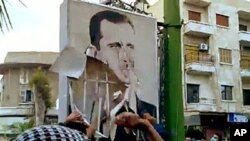Witnesses and activists in Syria say at least 62 people were killed when security forces opened fire in a crackdown on anti-government protests. Tens of thousands of demonstrators took to the streets nationwide on Friday, declared by young protesters to be a "day of rage" against the authoritarian government of President Bashar al-Assad.
Most of the deaths occurred in the southern city of Daraa, where the six-week-old uprising against President Assad began. Deaths were also reported in the central city of Homs.
Earlier Friday, the government said four of its soldiers were killed and two captured in what it described as a "terrorist" attack in Daraa. State-run media quoted a military spokesman as saying gunmen attacked a military post in the southern town at dawn.
In Damascus, more than 10,000 opposition activists were on the streets - the largest demonstration in the capital since the start of the protests.
Thousands more joined protests in dozens of other cities and towns, including Banias, Latakia and Qamishli. They marched in solidarity with the besieged residents of Daraa, which has felt the military crackdown the hardest. In addition to the bloodshed, Daraa's water, electricity and communications have been cut.
Syrian authorities blame armed gangs and infiltrators supplied with weapons from Lebanon and Iraq for inciting weeks of anti-government protests. The Assad regime claims the military action launched this week was intended to protect citizens.
President Assad has previously lifted the state of emergency in effect in Syria for decades, and promised political reforms, but that has had no visible effect on the protesters.
Syrian activist Rami Nakhle, who now lives in Beirut, said Friday's demonstrations were the biggest since the uprising began, and show that the Syrian people are no longer afraid to call for the government's ouster.
"The first persons who went to the streets in the beginning of this events, they want to topple this regime, but they cannot say it at the beginning. But now they start to say it. Now they start to say it, [and] they are protected by the crowd. The barrier of fear [has] start[ed] to fall. So people [are] not afraid anymore," Nakhle said.
For the first time Friday, Syria's banned Muslim Brotherhood urged people to join the protests. The group said the authorities' accusations that militant Islamists were behind the unrest were aimed at causing a civil war and undermining demands for political freedoms.
Activist Nakhle said even those Syrians who supported Mr. Assad are unconvinced by the government's claims.
"To fight Salafist armed groups, why to cut electricity? Why to cut medical aid? Why to cut water?," Nakhle said.
In Geneva, the U.N. Human Rights Council condemned the violence and called for an investigation, while in Washington, President Barack Obama imposed sanctions freezing property controlled by three top Syrian officials, the Syrian intelligence agency and Iran's Revolutionary Guard Corps. The Iranian entity is blamed for providing material support to Syria's crackdown on protesters.
Human-rights groups say more than 500 demonstrators have been killed since the uprising began on March 15. Most foreign media have been banned from the country, so independent verification of those reports has been difficult.













